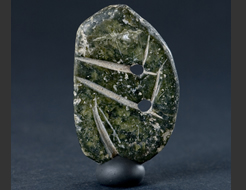|
||||||||||||||||||||||||||||||||
|
|
Museum of: Athens | |||||||||||||||||||||||||||||||
| Name of the artefact: Stone anthropomorphic amulet | ||||||||||||||||||||||||||||||||
|
Stone plaque of steatite, probably an amulet. On both
sides a human figure in a contracted position is depicted by five key
incisions. |
||||||||||||||||||||||||||||||||
|
WHERE IS IT AND MAIN
CHARACTERISTICS |
STATE |
|||||||||||||||||||||||||||||||
|
Department: |
Prehistoric |
Preservation: |
Very good | |||||||||||||||||||||||||||||
|
Inventory number: |
6004.33 |
Restauration: |
No restored | |||||||||||||||||||||||||||||
|
Name of the artefact: |
Stone anthropomorphic amulet |
Completeness: |
Complete | |||||||||||||||||||||||||||||
|
Object type: |
Amulet |
|||||||||||||||||||||||||||||||
|
Material: |
Green steatite |
|||||||||||||||||||||||||||||||
|
Methof of manufacture: |
Engraved |
|||||||||||||||||||||||||||||||
|
Decoration
type: |
Incision |
|||||||||||||||||||||||||||||||
|
Distinctive mark: |
The contracted position |
|||||||||||||||||||||||||||||||
|
DIMENSIONS |
PERIOD OF USE |
|||||||||||||||||||||||||||||||
|
Length (mm): |
- |
Epoque: |
Neolithic |
|||||||||||||||||||||||||||||
|
Heigth
(mm): |
39 |
Culture: |
- |
|||||||||||||||||||||||||||||
|
Diameter
(mm): |
- |
Period: |
Late Neolithic or Final
Neolithic |
|||||||||||||||||||||||||||||
|
Width (mm): |
23 |
Face: |
- |
|||||||||||||||||||||||||||||
|
Thickness (mm): |
6 |
Absolute chronology: |
5300-3300 BC |
|||||||||||||||||||||||||||||
|
Weight
(g): |
- |
|||||||||||||||||||||||||||||||
DISCOVERY |
||||||||||||||||||||||||||||||||
|
Date: |
1902 |
Country: |
Greece |
|||||||||||||||||||||||||||||
|
District: |
Thessaly |
Town hall affiliation: |
Volos |
|||||||||||||||||||||||||||||
|
Village: |
Dimini |
Discovery findspot: |
Neolithic settlement of
Dimini |
|||||||||||||||||||||||||||||
|
Condition of discovery: |
Archaeological excavation |
Discovery type: |
Deposit |
|||||||||||||||||||||||||||||
|
ANALYSES – DETERMINATIONS |
FILLED IN BY |
|||||||||||||||||||||||||||||||
|
Type: |
- |
Name: |
Alexandra Christopoulou |
|||||||||||||||||||||||||||||
|
Laboratory: |
- |
Institution: |
National Archaeological Museum -
Greece |
|||||||||||||||||||||||||||||
|
No./Code: |
- |
Date: |
21/11/2005 |
|||||||||||||||||||||||||||||
|
DEEPENINGS |
||||||||||||||||||||||||||||||||
|
Morphology of the object: |
||||||||||||||||||||||||||||||||
|
The soft dark green steatite, roughly ovoid in shape,
has been shaped to a human figure in the contracted position. A small part
of the stone has been sawn away at the bottom end of the plaque and from
that cutting a V-shaped groove upwards indicates and separates the
contracted legs from the body with the highly curved spine. Four incisions
on the body, engraved in the form of angles outline the bent arm. Two
holes have been drilled, each in the top of the two angles, most probably
to be used for suspension. This same pattern has been also exercised on
the other side of the plaque. The inspiration as well as the technique,
the economy in engraving as well as the clearness of the lines, all point
to the high intelligence the neolithic people had reached. |
||||||||||||||||||||||||||||||||
|
Decoration: |
||||||||||||||||||||||||||||||||
|
- |
||||||||||||||||||||||||||||||||
|
Inscription: |
||||||||||||||||||||||||||||||||
|
- |
||||||||||||||||||||||||||||||||
|
Analogies: |
||||||||||||||||||||||||||||||||
|
This artefact was found in the neolithic settlement of
Dimini, in Thessaly, Greece. This site was excavated by a greek
archaeologist, Christos Tsountas, at the beginning of the 20th cent., when
very little was known about the Neolithic Age in the academic world. The
publication, which appeared some five years after the excavation, in 1908,
is still a basic reference for the neolithic period in Greece. Small
details, however, such as the exact position of several objects, are
missing. Thus neither the exact position nor the specific archaeological
layer the stone plaque was found in, are known. Neither was it possible
for the excavator to interprete then the figure on the plaque hidden
behind the five crusial engraved lines. This was revealed many years later
and after the finding of another similar object, hidden also in the
thessalian plain. This second object (Flat pebble engraved as a human
figure seated in a highly contracted position) was found in a neolithic
site north of Dimini, called Magoula Karamourlar. Dim.0,04 X 0,033
m. |
||||||||||||||||||||||||||||||||
|
Interpretation: |
||||||||||||||||||||||||||||||||
|
Ornaments constitute an important category of objects
for the understanding of the neolithic way of life. Beads, bracelets and
pendants made of clay, stone, shell or bone are abundate in the neolithic
settlements. So, neolithic man had a keen appreciation of beauty and
naturally would like to make his presence felt, to distinguish himself
from those around, even to become more attractive to the opposite sex.
This specific pendant, however, could not be only decorative. The
dipiction of the human body in this highly contracted position leads us to
the fetus, that is in the period, that human being is in the womb (see
design of proposed schematical development). Pregnancy and delivery were,
of course, both very important and at the same time very dangerous phases
in their life. So, it is rather obvious that an amulet shaped as a fetus
would mean for the woman who had its protection, healthy pregnancy and
good luck during delivery. |
||||||||||||||||||||||||||||||||
|
Bibliography: |
||||||||||||||||||||||||||||||||
|
- |
||||||||||||||||||||||||||||||||

